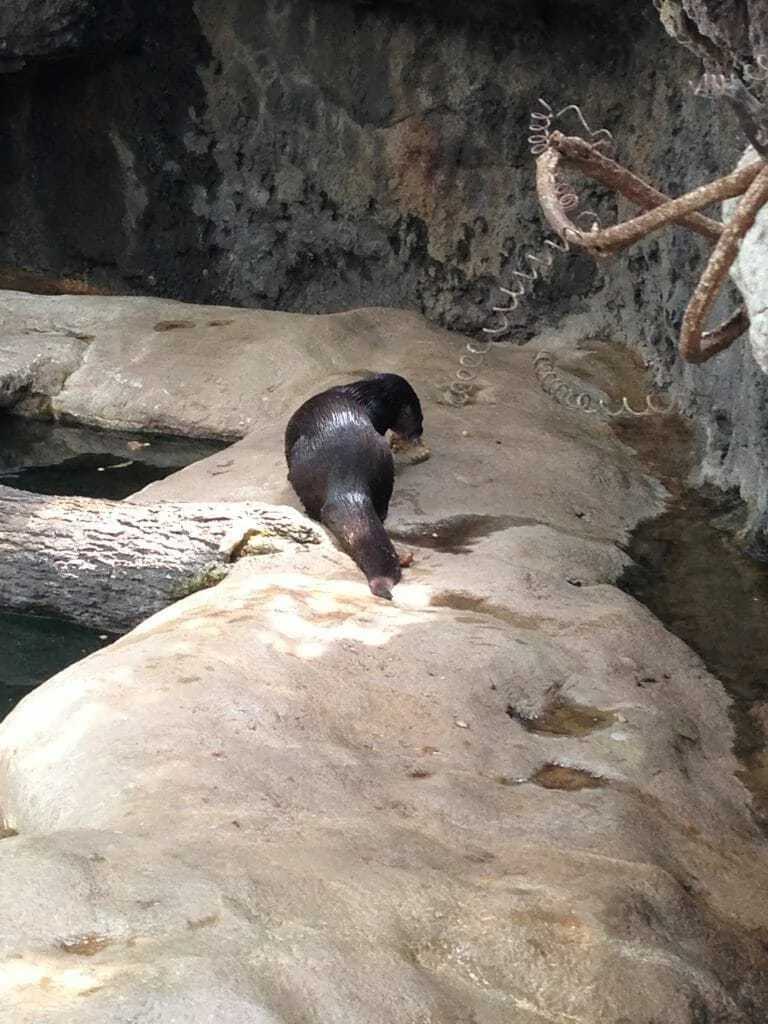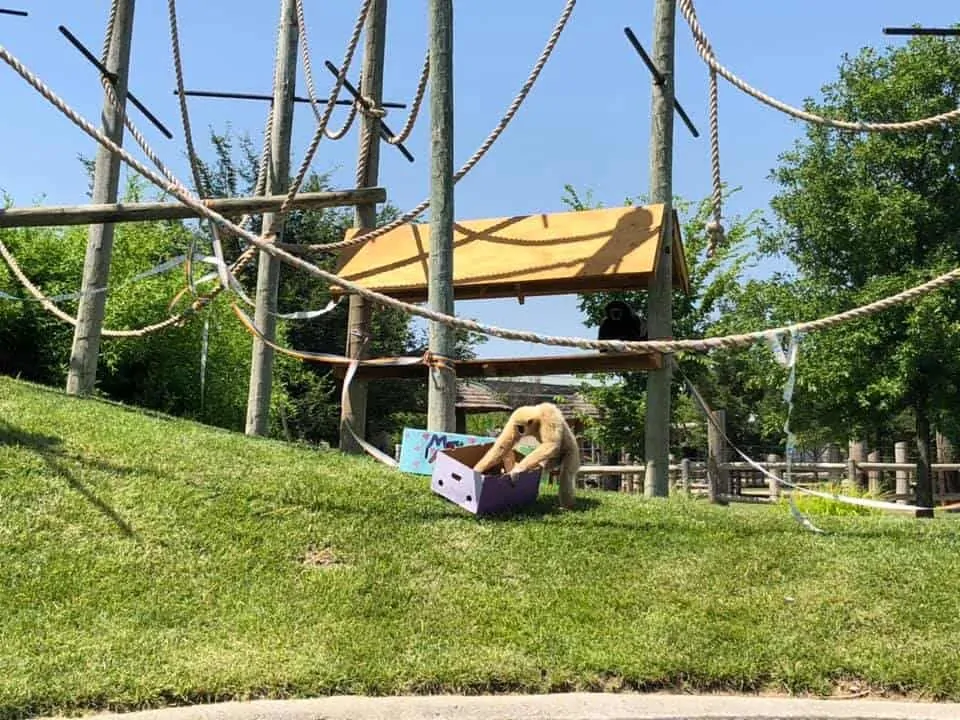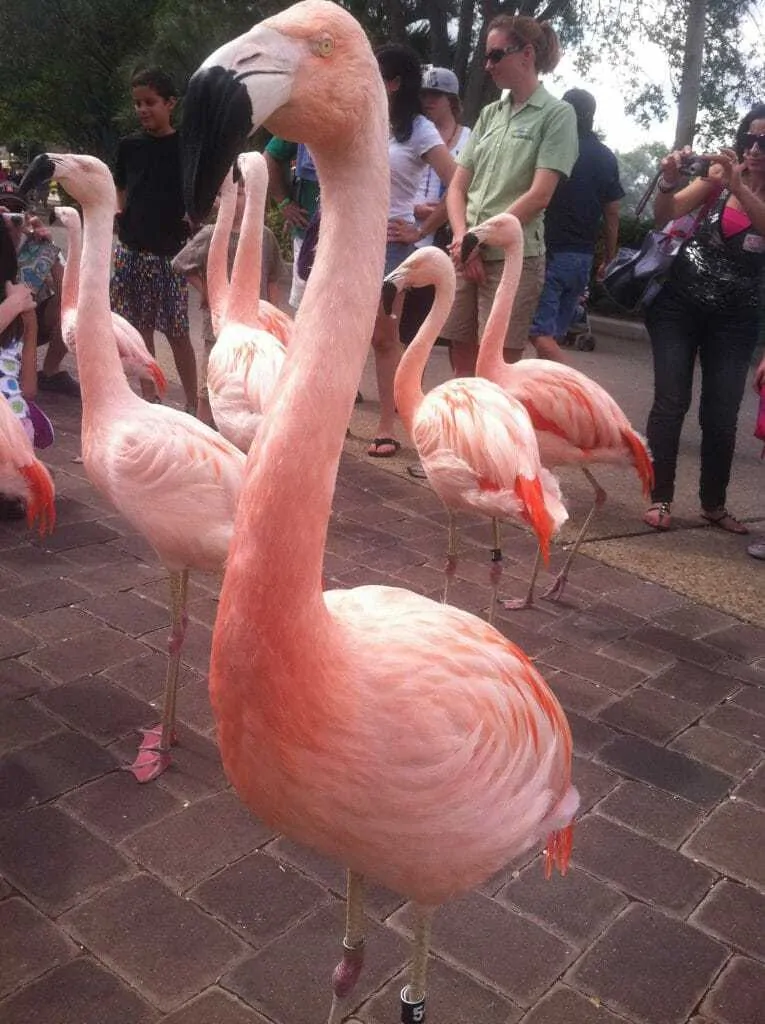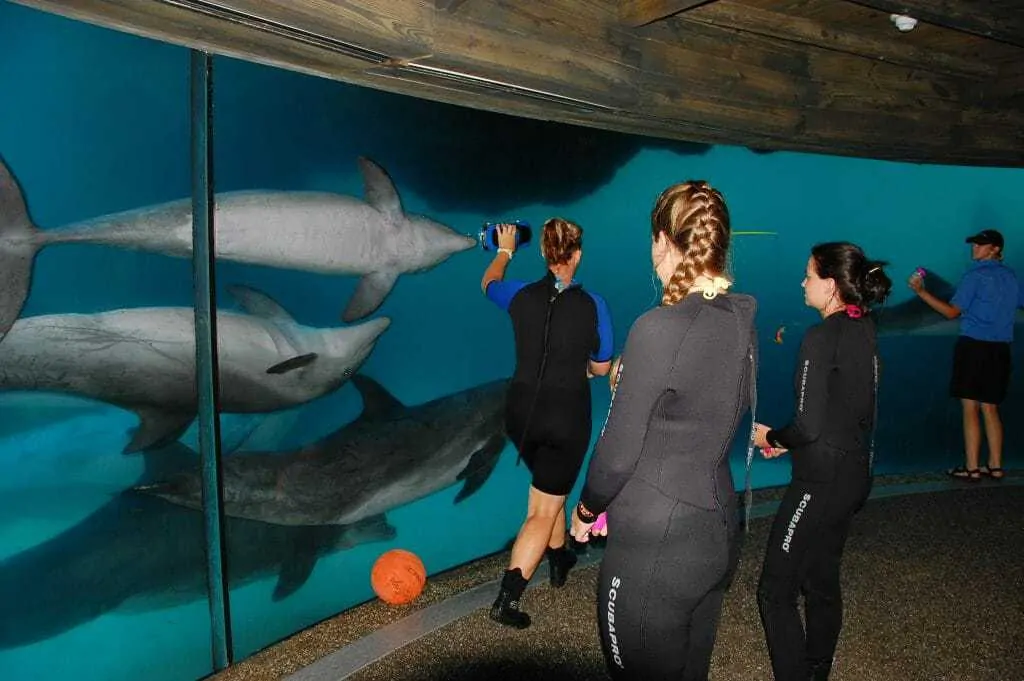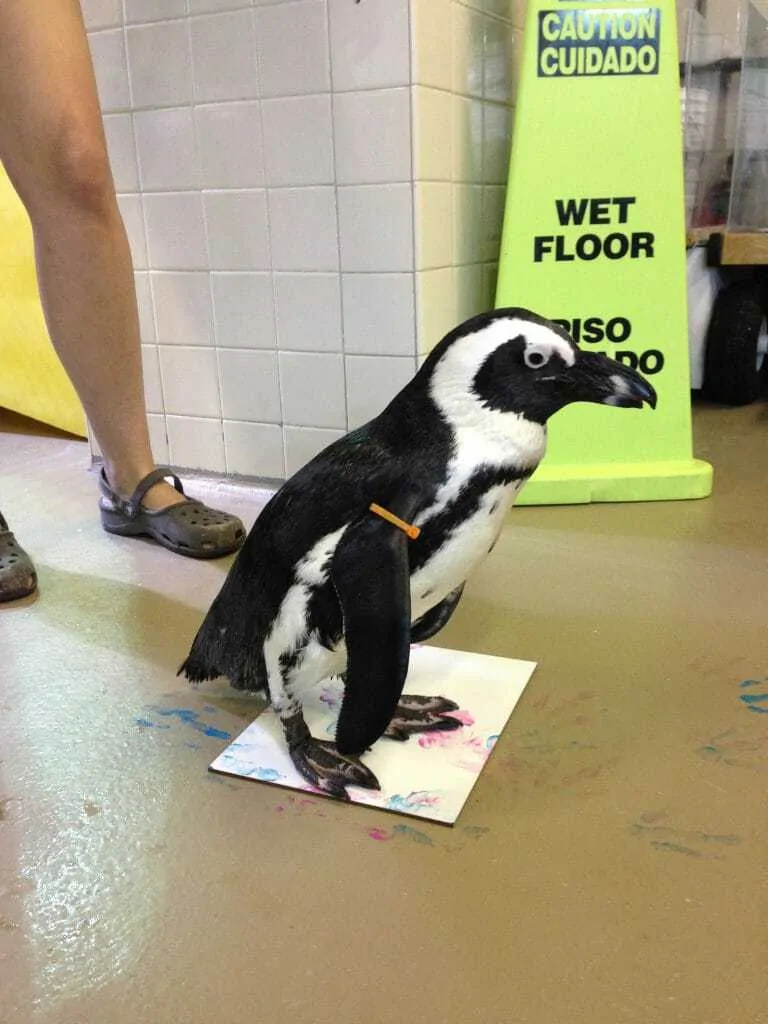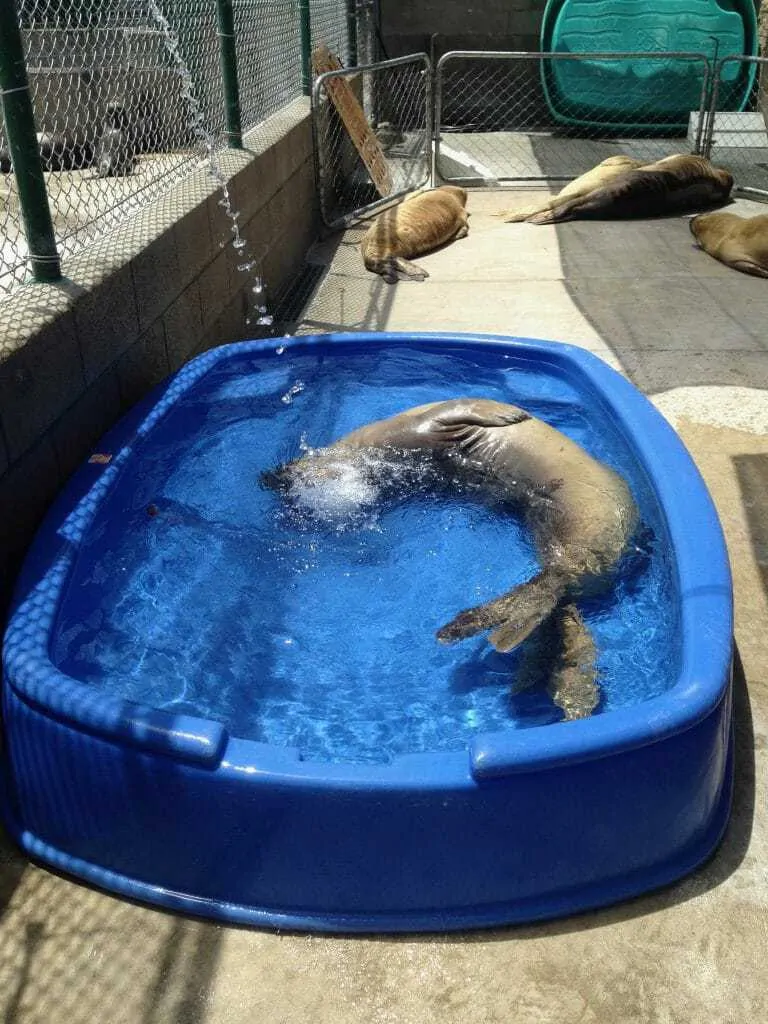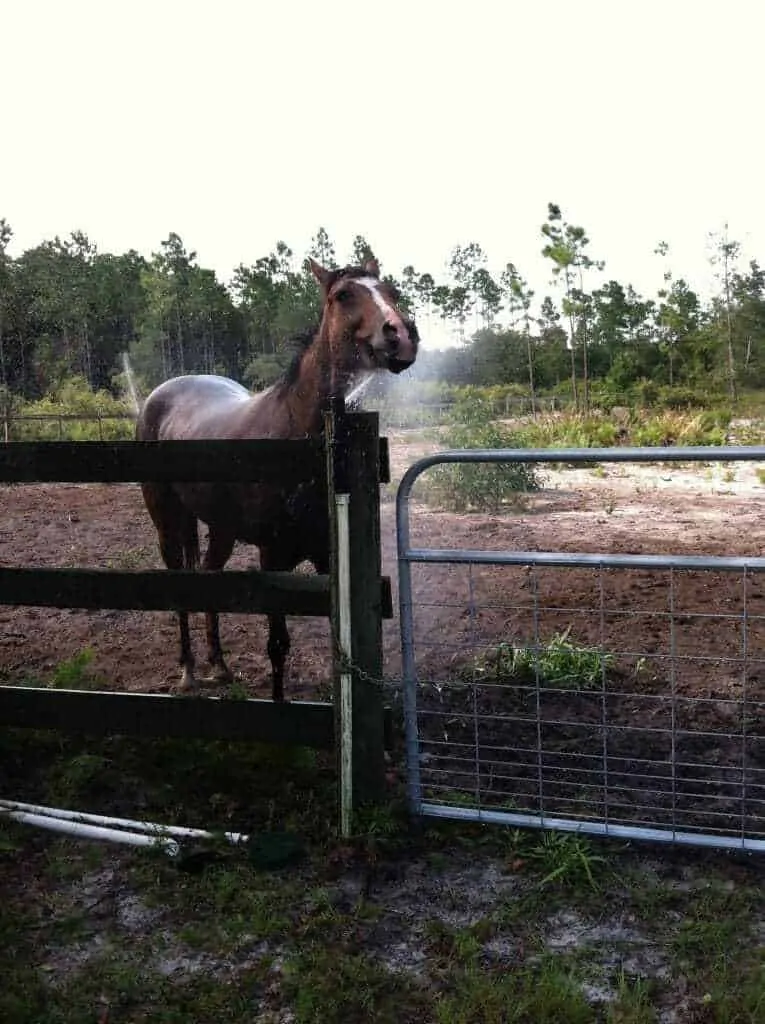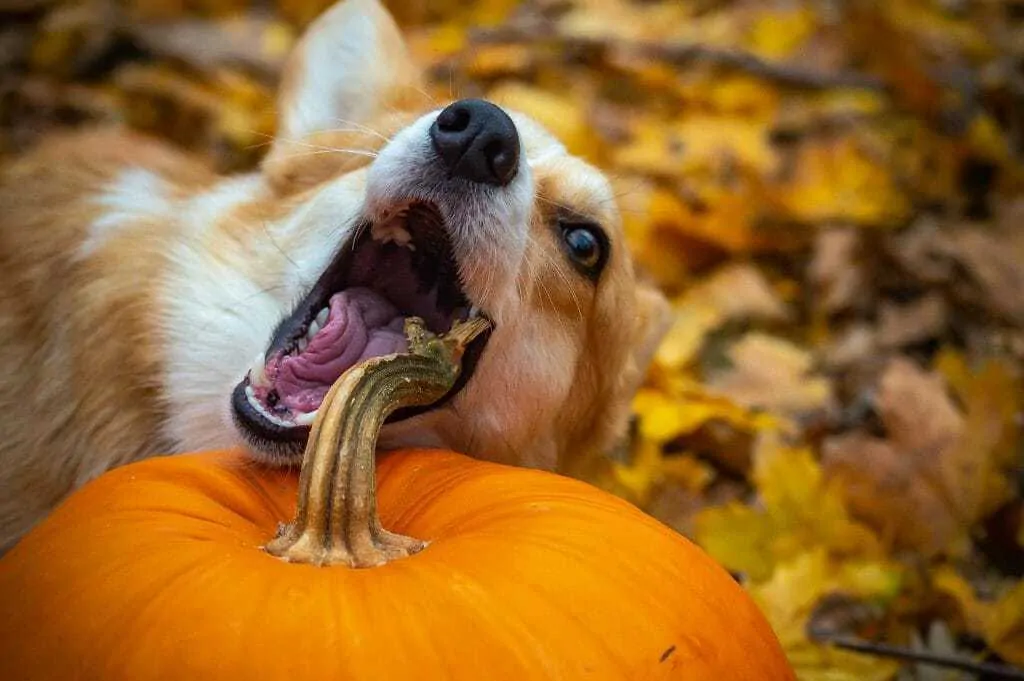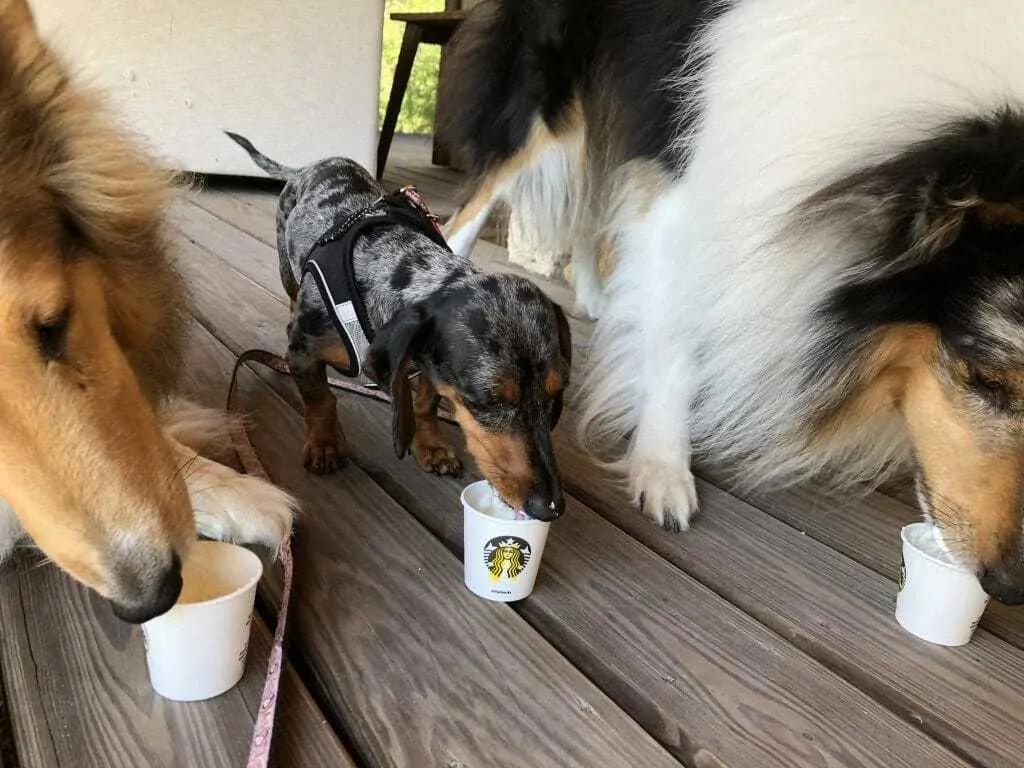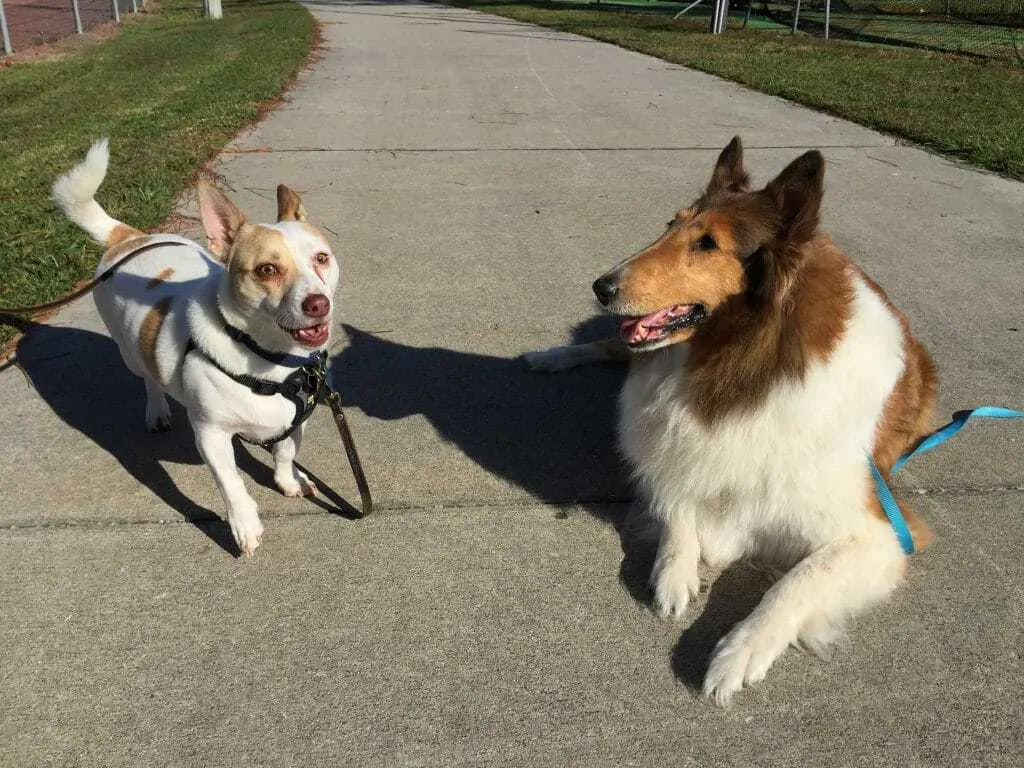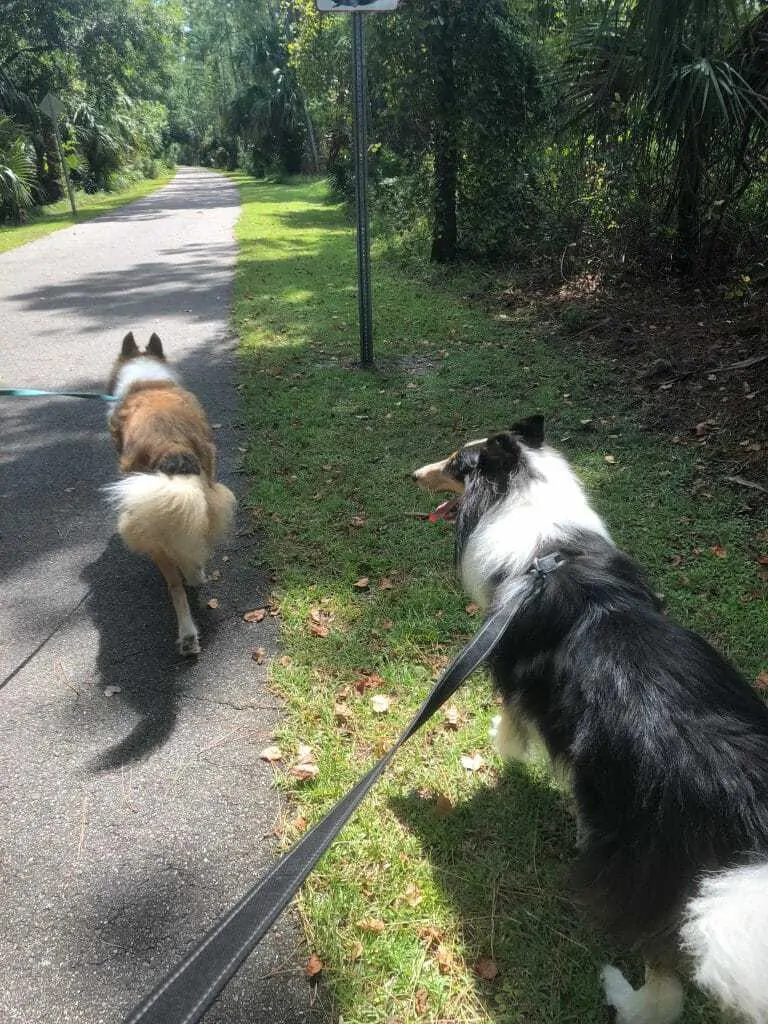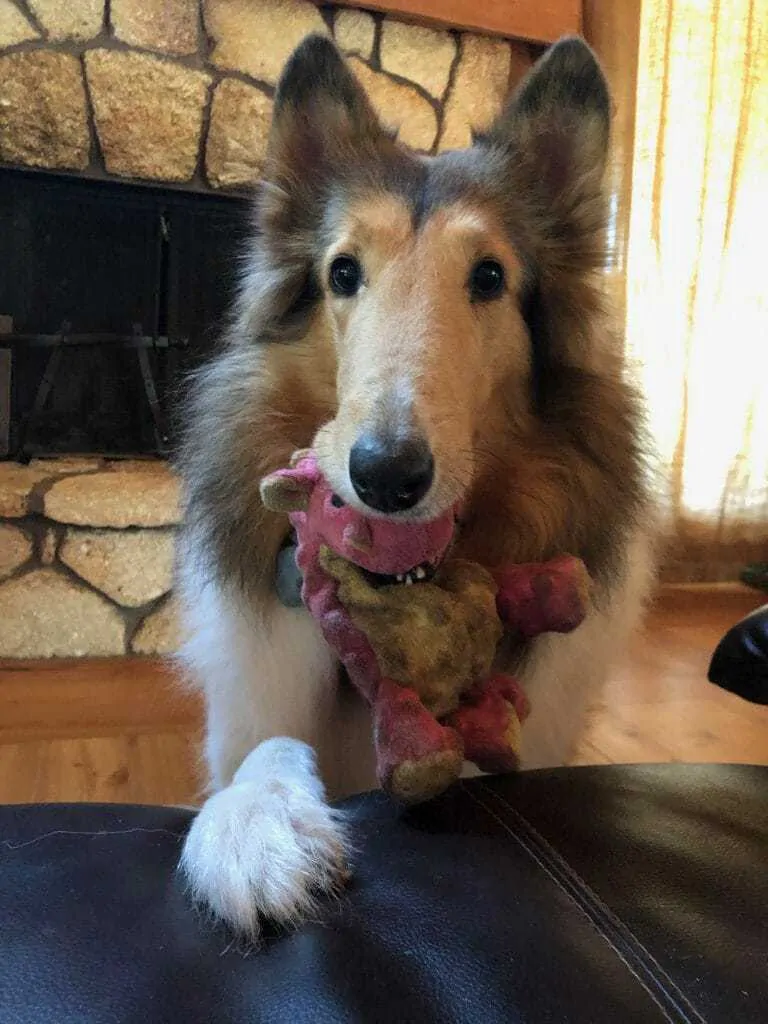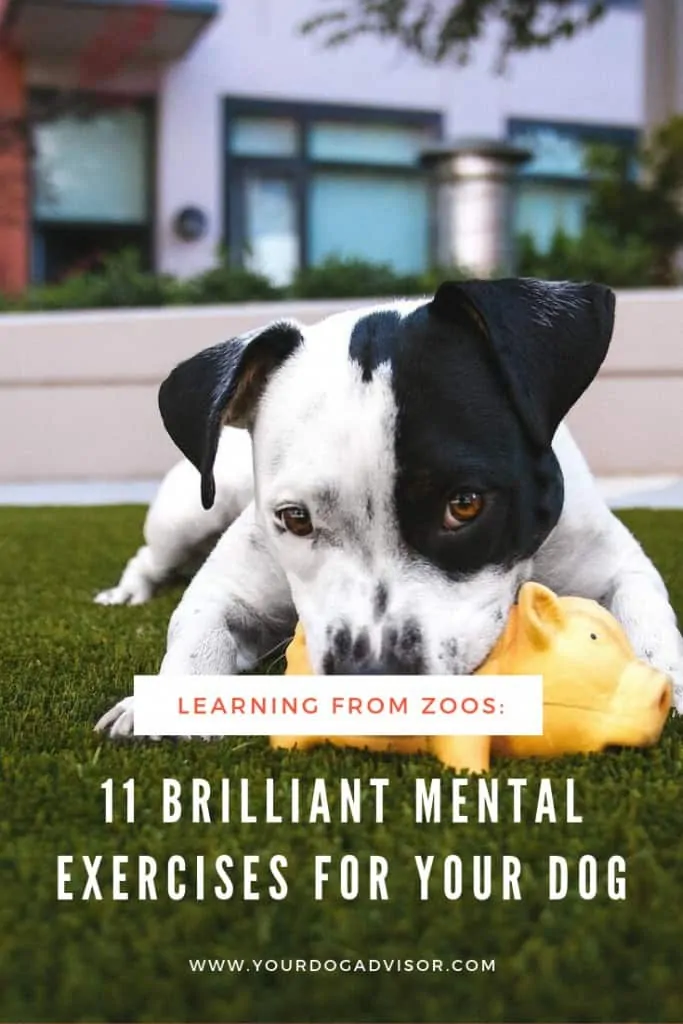If you’ve ever had to keep your dog cooped up for a day or two, you probably know that a bored dog can be pretty annoying! Mental exercise is one of the best ways to keep your dog, or any animal, entertained! Your dog is happiest when he gets to use his brain, and is probably even happier if food gets involved! Mental exercise is a great way to keep your dog happy, healthy, and out of trouble.
Dog getting mental exercise by using a treat ball.
Contents
Mental Exercise in Zoos
Zoo animals receive many of the same benefits from mental exercises as your pets do! Unlike your dog, the vast majority of animals in zoos are not domestic animals. This means that they need even more mental stimulation. Because animals in zoos receive all the food and water they need, they don’t have to spend their time searching or hunting for food. While they won’t starve, when they aren’t having to fight for every meal things can get a little boring, and that’s where mental exercise comes in!
What Happens When Zoo Animals Don’t Get Mental Exercise?
Just like your dog, when zoo animals don’t get enough mental exercise they can become “bored”. Also like your dog, this boredom can lead to problem behaviors. Some of the biggest downsides to this boredom include:
- Lethargy
- Weight Gain
- Stress
- Loss of Appetite
Thankfully, research shows that mental exercises reduce these behaviors!
Enrichment Schedules
To help make sure animals get enough mental stimulation, and they get a wide variety, zoos implement enrichment schedules. Enrichment is anything you add to an animal’s environment to help give them more mental exercise. Using an enrichment schedule helps zookeepers make sure that their animals are getting a wide variety of different activities, no matter who is working that day!
Here is an example of an enrichment schedule for an otter:
| Monday | Tuesday | Wednesday | Thursday | Friday | Saturday | Sunday | |
| AM | Puzzle Feeder | Hidden Food | Popsicle with Fish | Live Clams | Scent on Bedding | Fire Hose Toy | Puzzle Feeder |
| PM | Scent on Bedding | Towel Fort | Crickets | KONG toys | Extra Training Session | Bubbles | Live Fish |
Otter eats ice pop with dog food.
Likewise, dog interacts with ice pop
Mental Exercise in Dogs
Just like zoo animals, our dogs benefit from the addition on mental exercise. In fact, the more mental stimulation your dog receives, the less likely he is to develop or display many unwanted behaviors! Some of the many different problem behaviors that “bored” dogs can display include:
- Hyperactivity
- Lethargy
- Chewing/Destruction
- Stress
- Weight Gain
- Loss of Appetite
- and More!
Fear not! It isn’t that difficult to add more mental exercise to your dog’s day. However, it’s important for you to remember that your dog also needs variety. Your dog might love bully sticks, but if he gets one every single day he will grow bored, or fat, or both! The best way to make sure your dog is getting the most out of his mental exercise is for you to constantly switch things up!
Making watermelon pops for dogs.
Common Mental Exercises for Dogs
You can find many different toys, puzzles, and other mental exercises when you go to the pet store or look online. Pet stores provide you with a variety of different ways to keep your dog mentally stimulated. You can find all kinds of different activities, including:
- KONG Toys
- Rope Toys
- Puzzles
- Bones
- Antlers
- Bully Sticks and Other Chews
- And More
Different Mental Exercises in Zoos
As you saw above, even a single animal can experience many different types of mental exercises in a given week. Good zoos pride themselves on providing a wide variety of enrichment for their animals to enjoy and to keep them healthy and active. Below we list some of the many different types of mental exercise that zoos use with their animals.
Puzzle Toys
A puzzle toy is anything than an animal has to move or manipulate to get food out of. These toys provide a great opportunity for zoo animals to perform many of their natural foraging behaviors. In the wild, animals have to search for food by moving objects and manipulating things, puzzle toys are a great way to replicate this.
Clarissa DiCarlo: A gibbon manipulating a cardboard box to find food.
Novel Foods
Novel, or new, foods are a great way to keep things interesting for animals. You can spice up any animal’s day by adding a new (safe) food to their diet. One favorite in the zoo community is unflavored gelatin. Giving unflavored gelatin is a great way to add more water to an animal’s diet without feeding them too many calories. You can also add pieces of fruits, vegetables, meats, bones, fish, and more to keep things exciting!
An orca plays with a toy with pieces of gelatin stuck to it.
Frozen Toys and Foods
Popsicles are a great way to cool down a hot summer day, and animals love them just as much as humans do! Zookeepers make popsicles for their animals too, and they add a wide variety of different things to keep things interesting. Depending on the animal, you can add fruits and veggies, fish, meat, blood, bones, and even toys! You can even add toys and food to make things more interesting. Because they are frozen, it takes longer for the animal to get to the food or toy, which keeps them stimulated for longer periods.
Sea lions with a popsicle filled with fish and a toy.
Of course, when you are making popsicles or anything frozen, it is always a good idea to make more than one at a time. Especially with larger animals, big popsicles take a long time to freeze. If you prepare several at a single time you can just pull them out of the freezer and give them to your animals!
Several prepared ice pops from the previous photo.
Novel Scents
You can also provide new scents for your animal to explore. In the wild, animals experience all kinds of different smells. In fact, many animals track or follow those smells to find their prey! Some great enriching smells for carnivores include urine and feces from other animals, particularly prey species. However, this doesn’t work well in the other direction, prey species usually dislike scents from predatory animals!
Scents from other animals aren’t the only thing zookeepers give their animals. Many animals enjoy exploring other smells as well, like spices. Depending on the animal, some of the different spices that they experience include pumpkin pie spice, nutmeg, cinnamon, basil, ginger, peppermint, oregano, and more. Not all spices are safe for all animals.
Various spices, some can be used with animals.
Novel Activities/Experiences
Yet another wonderful mental exercise is allowing animals to experience new activities, places, and events! Zookeepers provide their animals with many different types of activities and experiences, including:
- Traveling to New Locations – In many zoos, the keepers bring animals on walks to different areas of the zoo. Some places even bring animals to other locations for educational presentations. Of course, it is important that they only choose individual animals that show interest in new experiences and do not display any signs of stress. Zookeepers extensively train and desensitize all animals in these types of programs to ensure they are entirely comfortable.
Flamingos on a walk under the supervision of their keeper.
- New/Unusual Toys – Sometimes you can only let animals use certain toys under direct supervision. Other toys you need to directly participate in or control.
Dolphins interacting with keepers in the underwater viewing window.
Dolphins interacting with toys through the underwater viewing window.
Penguins investigating bubble enrichment.
Penguin painting.
Sea lions with their paintings.
- Waterworks – Some activities enjoy swimming or playing with water jets, or both! You can provide water in the form of drips, hoses, sprinklers, and more. Not every animal likes water, and not every animal uses it the same way. Some animals enjoy playing in the water, swimming, getting a massage with the hose or sprinkler, and more!
Elephant seal at rescue facility enjoying a hose massage.
Horse enjoying a sprinkler massage.
Training Behaviors
One of the all-time greatest ways to work your brain is learning new things, and the same goes for animals! Zookeepers use positive reinforcement training to help ensure their animals get plenty of mental exercise and to teach them useful behaviors. A zookeeper teaching a dolphin to lie still on his back is actually doing two great things, training the dolphin so that they can eventually voluntarily draw blood and giving it a great brain teaser to figure out!
Dolphin trainer working on a fluke-hold behavior. This is the first step in training a voluntary blood draw.
Using Zoo-Inspired Mental Exercises with Your Dog
So what does all this mean for your dog? Not every mental exercise that zoos use will be beneficial for your dog, but you can adjust many different mental exercises so that they are perfect activities for your dog! Next time you go to the zoo or aquarium, keep an eye out for unique enrichment that you can potentially adapt to use with your pets at home!
Puzzle Toys
You’re already at an advantage with puzzle toys because many different companies and pet stores sell them! One of the most common puzzle toys are treat balls, which your dog rolls until the treats fall out. This mental exercise is wonderful because your dog gets to use his natural foraging behaviors to get to the food.
Another great mental exercise that your dog has to move around and manipulate to get food our of is a KONG toy. You can fill this with soft foods, like pumpkin, and then put it in the freezer. Once it’s frozen you give it to your dog and let them do the hard work! This is a great mental exercise to give them when you leave the house because they can come back to it later when it thaws as well!
Dog enjoying a frozen KONG in her crate.
Novel Foods
The vast majority of dogs love experiencing new tastes and foods. However, you should always make sure that whatever you feed your dog is safe for them. Once you know for sure that the new food is safe for your pup, go ahead and let them have a try! You can even take the zoo example of unflavored gelatin for a spin! Try adding some low sodium chicken broth and pieces of dog food as an extra bonus!
For some fun new foods, try feeding your dog:
- Canned Pumpkin
- Seedless Watermelon (no rind)
- Banana Slices
- Carrots
- Celery
- Unflavored Gelatin
- Mango
- Cucumber
- A Small Amount of Whipped Cream
- And More!
(https://pixabay.com/photos/welsh-corgi-pembroke-corgi-dog-pet-4237625/)
Though they might like chewing on it, you shouldn’t let your dog eat pumpkin stems.
Several dogs enjoying a small cup of whipped cream.
Frozen Toys and Foods
The perfect summer treat, popsicles can be a great way for you to help your pup cool off. Its really easy to make a popsicle for your dog. Simply take a small Tupperware container, fill it with water, and drop a few pieces of dog food, select fruits and veggies, and whatever dog-safe treat you’d like.
Another great alternative to the standard water-based popsicle is freezing toys and foods. You can add your dog’s favorite toy to their popsicle, make a popsicle out of canned pumpkin, or even freeze a carrot or large chunk of seedless watermelon!
Novel Scents
Dogs love experiencing new smells! Some breeds in particular, like hunting breeds, go crazy for a new scent. You can let your dog experience different smells while they are out on walks, of provide new scents for them to explore. One great way to let a dog get their sniff’ on is using a snuffle mat. You can place dog treats down in the snuffle mat for them to sniff around and find.
Puppy investigating the smells in a snuffle mat.
Novel Activities/Experiences
When it comes down to it, there are just too many new experiences and activities for you to do with your dog for us to list them all! Our dogs have the opportunity to experience and explore so many different places and things. However, just like zoo animals, it is important to know your pet. If your dog doesn’t enjoy new things, and seems nervous about going new places, you should move more slowly to help them become more comfortable. The process of making a dog comfortable with something potentially scary is known as desensitization.
Some of the different activities and experiences that you can do with your dog include:
- Meeting New People
- Meeting New Dogs
Two dogs interacting with one another.
- Meeting New Animals
Dogs meeting a horse, interaction occurs safely behind a fence.
- Going to New Places
Dogs walking at a new park.
- Playing With New Toys
This dog definitely needs a new toy to play with!
Dog swimming at a new park.
- And More!
Training Behaviors
Finally, training behaviors is the bread-and-butter of mental activities! Learning new things, puzzling out brainteasers, working through a behavior, these are all great mental exercise. Training is far from being restricted to zoo animals, but we should take a page out of the zookeeper’s book on this one. All zookeepers use positive reinforcement with their animals, and we should always use positive reinforcement with our dogs. Punishment and aversive techniques can cause your dog a variety of behavioral problems, and let’s face it, the science tells us that positive reinforcement works! So if you want a happy and healthy relationship with your dog, keep them mentally stimulated, use positive reinforcement, and always ensure you are reading your dog’s signals.

Jen Jones is a professional dog trainer and behavior specialist with more than 25 years of experience. As the founder of ‘Your Dog Advisor’ and the ‘Canine Connection’ rehabilitation center, she applies a holistic, empathetic approach, aiming to address root causes rather than merely treating symptoms.
Well known for her intuitive and compassionate approach, Jen adopts scientifically-proven, reward-based methods, encouraging positive reinforcement over punishment. Jen specializes in obedience training, behavior modification, and puppy socialization. Her innovative methods, particularly in addressing anxiety and aggression issues, have been widely recognized. Jen has worked with many of the world’s leading dog behaviorists and in her free time volunteers with local animal shelters and rescue groups.
